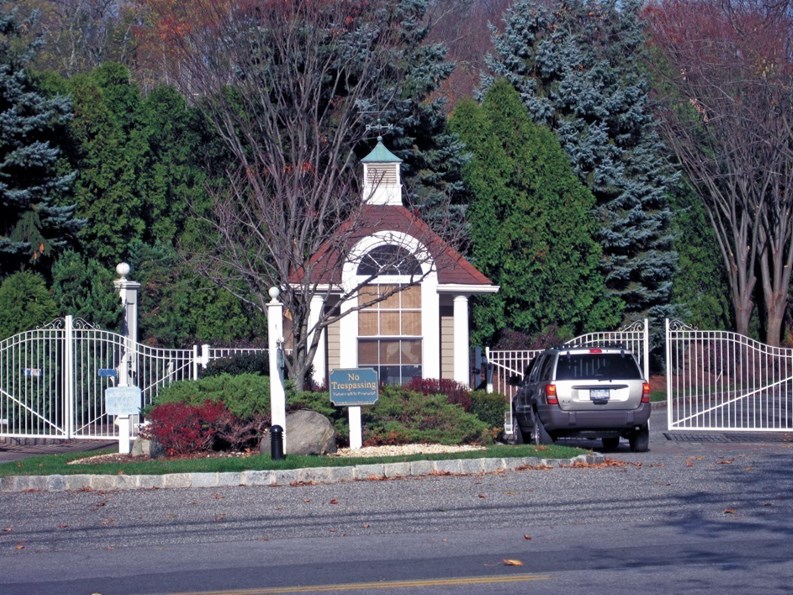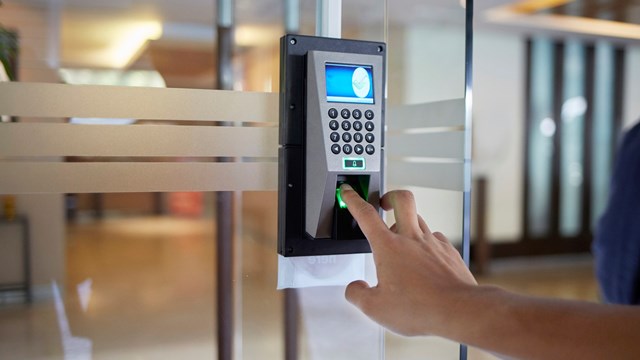Visible – and armed – security is routine in places where terrorism is predictable. Israelis pass guards daily at building entrances, coffee shops and restaurants, and shop entrances.
Life is simpler in New England, though not uniformly so. Amid gentrification efforts, more condominiums have been placed in transitional areas, and the need for better security has increased. And threats of theft, damage and domestic violence exist even in low-crime areas. Because of these sobering facts, community associations may want to invest in live, on-location security guards.
The decision to use on-site guards, while made at the management or board level, should include owners. That increases buy-in and decreases dissension. “In a condo environment, owners can be a small group that’s very vocal; they can make life really difficult for the management team,” says Elliot Boxerbaum, CPP/CSC, president and CEO of Security Risk Management Consultants, Inc., headquartered in Ohio. His firm provides security consultations to 29 states and several foreign countries. Other experts agree, adding that involvement pays off in security awareness, and cooperationwith the final plan.
Location, Layout, Lifestyle – and Costs
The primary considerations in evaluating security needs are: location, physical layout, occupants’ lifestyle/ age group, and costs. Selecting on-site security guards requires research – and legwork. There may be communities where guard presence relates to reduced insurance policy premiums, or residents are older, requiring hands-on assistance and emergency care response. Other communities may need a more security-alert, highly trained force. There are different strokes for different folks, and experts can suggest all kinds of measuresfor monitoring and protecting residences, and discouraging criminals.
With police budgets being reduced in many municipalities, condominium boards may need to supplement security with guards. Criminals may target high-income condos in low-crime areas, seeking the ease of unlocked doors and minimal protections. Just as readily, theelderly may be perceived as perfect victims.
Before choosing a security force, let professional eyes survey the situation, weighing the various levels of risk. Resident boards must also balance need against costs for the best kind of protection they can afford. Visible, well-trained security forces are a significant deterrent; supplemental technology helps ensure a safe environment – or acombination of the two. Seek several opinions in deciding what to put in place.
“I think security and safety go hand in hand,” says Bret Almassy, vice president of residential services for AlliedBarton Security Services, a nationwide firm employing 54,000. “From a security standpoint, the number one thing is perception. Do (residents) want to be perceived as an open community, where people can come and go with ease, or do people want a secure environment, where noteveryone can come in and get out?” A security plan starts at this point, and builds on it.
Boxerbaum’s mind moves outward, in concentric circles from the units, in making security assessments – evaluating the physical layout and openness of a location through lighting, parking, line-of-site views, garages, etc.
Not Every Condo Needs Guards
Mark Calnan, general manager of G4S Secure Solutions USA (formerly Wackenhut), oversees operations in eastern Massachusetts, Maine and New Hampshire. His assessment begins with a conversation. “What’s been their experience? Have there been unwanted people, or break-ins, at that location? I don’t believe that every condominium location does need (guard) security, but most places, oncethey get it, say ‘this is really nice.’ There’s really no substitution for the feeling of security and safety.” As an FBI agent for 24 years, Calnan lived in dangerous locations, where security was often compromised. “It was a horrible feeling,” he said.
Physical layout is important, Calnan says. “We have to see the place, see the type of community it is – whether it’s high-rise, or gated, whether there’s access control.” There’s a little trick one can use in gauging the situation. “If I can walk into a community, walkin a front door, make my way up the elevator, they need security,” says Calnan. “I could have been anybody.”
The layout can actually reduce the number of guards needed. If access points are carefully limited and protected, a large, 1,000-unit developmentmay not require any more manpower to protect than one half its size.
Some 500-unit or larger condominium areas have guards in every building and at the gates, as well as on patrol, Calnan says – but that’s up to the residents and their representatives, as well as what they are willing to pay. “There’s no magic number,” he says. “They have to decide whether it’s feasible to cover the location with one guard, or more, whether they want somebody to walk around, or drive around. And someone has to be at thegate; it’s all up to the condo people.”
There’s another determinant of threat level. Boxerbaum walks the site looking for “signs of social disorder – bottles, broken glass, condoms, etc., around the property, under bushes.” Such conditions tell criminals that people don’t really care about the space, and there’s an opportunity to commit crimes. “Areas where there are none of these signs, where lawns are manicuredand there’s no trash lying around, make a very important statement to criminals,” he says.
Background Checks
A thorough assessment looks at doors, locks, key policies, lighting, vehicle and pedestrian traffic patterns, as well as personnel. “What type of background investigations are done on the maintenance staff?” he says. “That’s a huge issue. Do you require that your contractors run background investigations before you ever issue someone a key? You can set that up with most security service providers.”
To Murray Levine, a retired Wacken-hut executive, now a consultant to G4S, access is a critical determinant of vulnerability. Boards must establish who guards should allow through the access points, “to be assured that, whenhomeowners are not in residence, only authorized people can come in.”
This relates specifically to the lifestyle and protection wishes of the residents. It’s also where technology comes in. G4S, for example, places information about family members, maintenance and repair people, delivery firms, etc., in a computer-driven access control system guards can access. In situationswhere a former spouse or live-in is considered a threat, photographs and information about them is provided.
Technology also allows for residents’ contact and health information to be available in emergencies. Older populations may rely on guards for a helping hand, as much as for security. Check whether firms train guards specifically for that purpose – to help with packages or flat tires, or check on unanswered doors or phones. Because residents are older, there may be a greater need for protection. Here, too, boards may want to look at security services trained in rescue or linked to emergency teams.
On Hiring Guards
To clearly understand their needs, condominium boards should consult several firms. AlliedBarton’s Almassy advises asking firms to make presentations, based on what should be free, in-person site evaluations to determine what’s already in place, and what’s missing. “Call other condo associationsto determine the level of crime in the area,” he says. “You don’t really want to leave (the choice) in the hands of one or two board members.”
Levine for his part advises boards to look closely at the security firm’s quality. “Go visit the offices of the proposed agency, interview their management staff,” he says. “Forget everything said in the (sales) presentation. Visit the offices, look at the training, look at the personnel files. That’s how you make the decision. I’d have them take me out to different sites, and I’d talk to the real people on site, the guards and the clients they work for.”
While the boards at smaller areas may want to train their own guards, Boxerbaum holds that it’s generally preferable to have them trained by the provider, who is aware of all considerations for safety, and can cover absencescaused by vacations or sick days, bonding, licensing and supervision.
Different levels of security range from those trained to assist residents and provide a safety presence, deterring would-be criminals, to highly trained guard with military or police backgrounds, specializing in detection and prevention of crime. When security analysts survey a site, they’ll recommendthe kind of security that’s needed.
AlliedBarton maintains trained security officials on eight levels, ranging from residential to institutional or governmental facilities. G4S clients range from nuclear facilities to condominium communities, covered within three defined levels of training –each with more expertise than the previous level.
Law Enforcement Backgrounds
The most highly trained guards come from law enforcement and military/ military police backgrounds, or have criminal justice degrees, with individualsat all levels vetted for psychological traits, drug use and criminal histories.
The firms consulted for this article were adamant about this process. In this economy, with more people offering security assistance, hiring comes with a kind of “buyer-beware” caveat. For that reason, it’s not wise to decide safety on cost alone. “If it’s a price-driven event, they’re not going to get the level of security they’re hoping for,” Levine says. “Some [security] agencies send ‘bodies’ out – not trained, and lacking backgrounds. When they (boards or managers) drop to that level, they mayas well not have any [security].” And, Levine adds, insurance and bonding, as well as training, are important. “I wouldn’t hire without a $5 million certificate of insurance, and an agreement between the board and the security firm where the board is held harmless for any breaches.”
Daniel R. Mailhiot, field operations manager for New England Security & Public Safety Agency, Boston, cautionsagainst guesswork. “You can’t put a price on protection.” He also assesses the intrinsic security of the existing layout, as well as neighborhood data before offering a guard security plan. He’s seen clients choose lower-priced setups, only to return to his firm having learned first-hand the value of better training, responsiveness and supervision of guards.
Live Guards and Technology
Calnan agrees, but says where money is short, a combination of live guard service and technology may provide a workable solution. In his view, failing to respond quickly and appropriately leaves a development vulnerable. “The wave of the future is to provide manned guarding with technology.” Some firms, like G4S, provide the technology and work jointly with what a client may already have, such as camera surveillance, to set off an alarm immediately. Almassy, at AlliedBarton, says surveillance can be combined with a loudspeaker to interrupt intruders.
An underpaid, undertrained security guard may not be motivated enough to provide good service. A well-trained, well-paid security officer stays longer, gets to know residents and the location, and provides better security.
Bottom line, Almassy says: It’s aboutdeterring crime. “A criminal usually works a certain area of town; if there are two or three condos, and one has a fence or a security guard and the others don’t, he’s gonna move on to the next place.”
Ann Connery Frantz is a freelance writer and a frequent contributor to New England Condominium magazine.







Leave a Comment